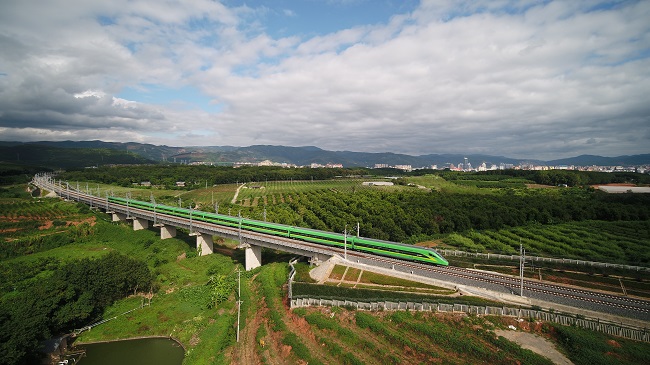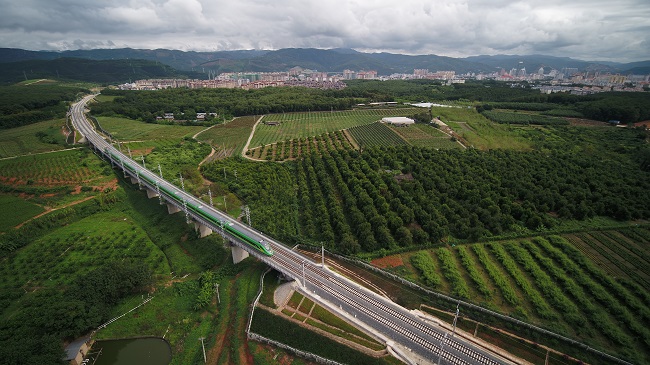China-Laos Railway: Bridging borders, overcoming challenges
Starting the day with rice noodles in Kunming, China, and ending it with coffee in Vientiane, Laos — thanks to the China-Laos Railway, a new way of life is emerging with seamless cross-border travel.

The China-Laos Railway Yumo section
Throughout this year, the China-Laos Railway has shown robust growth in both passenger and freight transportation. From January 1 to October 31, the railway had transported over 16 million passengers and more than 16 million tons of goods, including over 4 million tons of cross-border cargo. Since its opening in December 2021, the China-Laos Railway has operated more than 60,000 passenger trains, carrying 41.7 million passengers and transporting 46.7 million tons of goods, with cross-border cargo reaching 10.7 million tons as of last month. These figures not only demonstrate the railway's transportation capacity but also highlight its significant contributions to regional connectivity and cultural exchanges.
The China-Laos Railway stretches from Kunming in Yunnan province, China, to the Laotian capital of Vientiane, covering a total length of approximately 1035 kilometers. It comprises the Kunyu section and the Yumo section in China, and the Mowen section within Laos. The Yumo section, constructed by CCCC Second Harbour Engineering Company, includes the 17th station project located in Jinghong city, Xishuangbanna Dai autonomous prefecture, Yunnan province. The mainline extends approximately 14.7 kilometers, featuring one of the most challenging tunnels along the entire route — the Xishuangbanna Tunnel.

The China-Laos Railway Yumo section
Since 2016, the builders have dedicated five years to overcoming world-class engineering challenges one after another in Yunnan.
According to the tunnel's design, the project team initially adopted a "long tunnel, short excavation" method, digging two auxiliary tunnels from one side of the main tunnel entrance, then simultaneously advancing towards both ends from inside the tunnel, allowing four work surfaces to progress simultaneously to save time.
However, at the beginning of tunnel construction, the team faced unexpected challenges. While the design indicated mostly Class III and IV surrounding rocks in the tunnel area, the Xishuangbanna Tunnel traverses the Lancang River fault zone and multiple fault lines, revealing extremely weak and fragile surrounding rocks, with Class IV and V rocks making up 98 percent. This led to the high risk of geological hazards such as collapses, sudden water influxes, and significant deformations, categorizing the tunnel as high risk.
The project team employed advanced drilling and comprehensive geological forecasting methods, predicting geological conditions accurately and adjusting excavation cycles meticulously. They also utilized a "short excavation, fast cycle" excavation method and mechanized operations to achieve rapid excavation, support, and closure, enhancing rock stability and effectively controlling rock deformations.
However, once inside the main tunnel, collapses occurred approximately every three days, with major collapses every week, each taking more than 10 hours to address. This was accompanied by significant rock deformations, leading to arch deformations exceeding a kilometer. Consequently, even with all four work surfaces operating simultaneously, tunnel completion appeared to be far off.
The most challenging area was the direction of the small-mileage No.2 inclined shaft. This section involved a single-head excavation spanning 2,552 meters, almost entirely composed of high-risk Class V rocks. After over two years of construction, around 700 meters had been excavated.
At this critical juncture, chief engineer Zhou Yang boldly proposed the "detour and parallel guiding" construction method, which involved creating an auxiliary tunnel parallel to the main tunnel from inside and then rejoining the main tunnel before the main tunnel construction progressed. This divided the single-head excavation tunnel into two sections, increasing work surfaces and reducing excavation difficulty. This new approach, continuing the "long tunnel, short excavation" concept, received unanimous approval from the project owner, designers, supervisors, and internal and external tunnel experts.
In 2019, within just 10 months, the "detour and parallel guiding" method was successfully reconnected to the main tunnel, creating a new work surface for the No.2 inclined shaft, propelling the tunnel forward with the momentum of the "long tunnel, short excavation" method.
Simultaneously, through the combined effect of the "weak rock parallel operation method" and the "four-step construction management method," the project team significantly improved tunnel excavation efficiency. They not only achieved a remarkable increase in the average monthly footage of Class V rock areas from 45 to 90 meters but also set a record for the No.2 inclined shaft tunnel with a monthly footage of 106.5 meters.
On January 26, 2021, the Xishuangbanna Tunnel was successfully completed, marking a significant milestone in the China-Laos Railway project.









